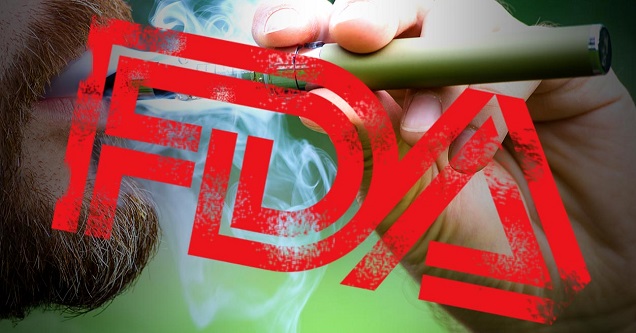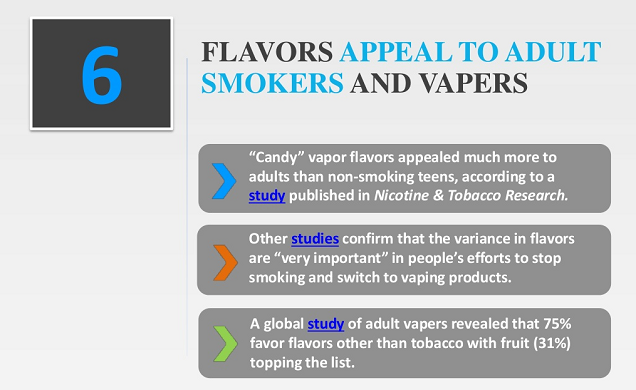
With more vaping bans proposed, some movements on the FDA regulations, a couple of new e-cigarette studies, several great articles on vaping from inside and outside the community, and one of the most thoroughly absurd winners of “Bullshit of the Week” so far: here’s the Week in Vaping.
E-Cigarette Research and Studies
A new study looks at how the perception of harm from second-hand vaping correlates with support for bans on indoor vaping, and – shockingly – finds that people who thought second-hand vaping was harmful to their health were more likely to support restricting vaping indoors. Additionally, most of the participants thought it was “moderately” harmful to their health, and generally supported restrictions. It reads as if increasing perceptions of harm to increase support for “clean air” policies is the core goal, rather than to determine whether there is actually any harm, as Dick Puddlecote comments about the study here.
There have been claims that a case report has found evidence of diacetyl-related lung damage in a vaper. The patient in question was a 60-year-old cigar smoker – which muddies the waters in terms of pinning down the precise cause – who was diagnosed with acute hypersensitivity pneumonitis. It had cleared up within 72 hours and after treatment with antibiotics alone. The fact he stopped vaping and remained clear of problems at future scans does strengthen the case, but there was no confirmation diacetyl was present in the liquid.
Legislation, Regulations and Vaping Bans

The FDA’s deeming regulations for e-cigarettes have been sent to the Office of Information and Regulatory Affairs for review, a step designed to look at the implications and unintended consequences of the regulations. We’re hoping the fact that these regulations will remove the vast majority of e-cigarettes from the market will be stressed, and the Smoke-Free Alternatives Trade Association (SFATA) is working to ensure these concerns are voiced.
New proposals in the Australian Capital Territories aim to ban the sale of e-cigs to minors, ban vaping wherever smoking isn’t allowed and heavily restrict marketing, including promotions, customer reward schemes, giveaways and sponsorship deals. Technically, only non nicotine-containing are even legal for possession and sale without a license, so things are still looking grim for Australian vapers.
Broome County, New York has banned vaping in and around government-owned buildings, but didn’t go as far as they were originally intending, which was to extend the rule to all places smoking is currently banned. The next move is likely going to be to bring it in line with existing clean indoor air rules, with some legislators talking about banning vaping in parks in the future.
Yuba City, California has actually approved a ban on vaping in parks, becoming the latest in a long line of localities to make a decision in no way backed by scientific evidence of risk by preventing people from vaping outdoors. The decision was supported by a couple of doctors who were in attendance at the meeting, and that was apparently enough proof for the vaping-averse local government.
Hutchinson, Kansas is moving towards a vaping ban in all public indoor spaces, although exemptions look to be on the cards for specialty tobacco or vaping stores.
Associate Professor Marewa Glover of Massey University in New Zealand has criticized a recent decision by the University of Otago to ban vaping on campus, saying the move is based more on prejudice than on science, pointing out that research shows no risk from second-hand vaping and that vaping is not confused for smoking, even by children.
Vaping-Related News and Blog Posts

SFATA has released a list of the top ten vapor facts to address some of the misconceptions surrounding vaping. It doesn’t really present any information not widely available and already known to anybody who actually goes looking for evidence of vaping-related claims, but puts several key points into bite-sized form, and will hopefully spark some otherwise misled legislators into digging a little deeper.
Ex “Winston Man” David Goerlitz, who received a WHO medal of honor for turning against the tobacco industry and starting campaigning to inform youth about the risks of smoking, has sent his medal back to them in protest over their position on e-cigarettes. His stance is a little extreme – pushing the corruption angle a lot in an interview – but returning the medal is a strong statement, none-the-less.
A Milwaukee Journal Sentinel report looks at the issue of potentially harmful flavoring chemicals in e-liquids, probing the issue in-depth and drawing attention to the discrepancy between different labs’ test results for diacetyl and acetyl propionyl. It also suggests that manufacturers should pay for more sensitive tests, despite the fact that the chemicals were only detected at levels that would be picked up by Enthalpy and similar labs’ tests.
The Guardian has published an uncharacteristically positive article about e-cigarettes, calling the devices a “consumer-led revolution” and taking an objective look at the available evidence.
Although I disagree with him, Simon Chapman has put out a well-written article about the hype surrounding e-cigarettes, making several flawed arguments – for example, likening e-cigarettes to “low tar” cigarettes and claiming (in spite of the conclusions of the available body of evidence) that e-cigs aren’t that effective for helping smokers quit – but generally articulating the anti-vaping position pretty well. Although he does call vaping activists “self-absorbed misanthropes,” it is more objective and rational than most anti-vaping posts I’ve seen, and is well-worth a read.
Chapman also rightfully states, “No one sensible makes the argument that e-cigarettes are likely to be even remotely as harmful as smoking.”
With cigarettes being deeply ingrained into the culture in China, the rise in vaping there is good news, despite what the increasingly Orwellian WHO would have smokers believe, argues Sally Satel for Forbes, who calls on the organization to quit the double-speak about vaping.
There’s also a great post on Facts Do Matter called “Engaging the Professionals,” which talks about author Paul Barnes’ meeting with a stop smoking service to answer some questions about vaping for them, as well as touching on e-cig safety, vaping in public and the possibility of UK pharmacies stocking e-cigs in the process.
Finally, the Kooper 200 W Plus is set for release some time towards the end of the month, offering up to 200 W of power and temperature control for nickel, titanium and stainless steel coils. It’s available for $69.95 on KanVape or for an impressive $49.99 on VaporTek USA.
Bullshit of the Week: E-Cig “Burns a Hole in Man’s Lung”

Don’t you just hate it when droplets of hot e-liquid spit out of your atomizer, use their propulsion and navigation systems to maneuver their way right down your windpipe (instead of just hitting your mouth or throat) and then take a perfect turn down into your bronchi, inexplicably staying a sufficient temperature throughout the journey to be capable of burning a hole in your lungs when they finally get there? Yeah, we’ve never had that happen, and despite media claims, that is not what happened to Richard Courtney either.
The story centered on claims that Richard was walking home from a friend’s house and started coughing, with the taste of “fluid” in his mouth. He was in pain as if he had a trapped nerve, and by the morning struggled to breathe properly. The only “confirmation” offered of what supposedly happened was a nurse demonstrating to Richard that the e-cig was spitting out liquid.
Myth-busting site Snopes was quick on the mark to declare the story unproven, pointing out the total lack of medical information in the article and making the key point that:
It appeared readers were meant to infer that very hot e-liquid shot out of the vaporizer's tank into the injured man's mouth (without causing damage), then traveled down his throat (similarly not leaving any burns) before landing inside his lung and “burning a hole” in it. We were unable to find any reports of lung injuries that even remotely matched the Sun's claim, but presumably such an adverse reaction would have previously befallen marijuana smokers, regular smokers, chefs, firemen, and others regularly exposed to inhalation of fumes or steam at a high temperature. Moreover, Courtney's device (while very common) was on the low end of wattage among vaping “mods,” a number of which are capable of wattages nearly ten times the amount reported.
Dr. Farsalinos points out that it was likely a case of pneumothorax, which is linked to past smoking. He writes:
A case of spontaneous pneumothorax, for which SMOKING (current or past) is a risk factor, is presented as “burning hole in the lung” (a term which sounds like a joke) caused by e-cigarettes.
It is never too late to stop the misinformation.
I feel sorry for the patient, not only about his episode of pneumothorax but mostly because he is probably convinced to quit e-cigarette use and relapse to smoking!!!
Perhaps this is why medical details were curiously missing from the article. In other words, it was total bullshit.
Anything to Add?
As always, we’ve done our best to pick up on all of the major stories of the week, but we may have missed something: if so, let us know in the comments and we’ll add it in! If not, check back next week for another update on what’s been going on in the world of vaping!

